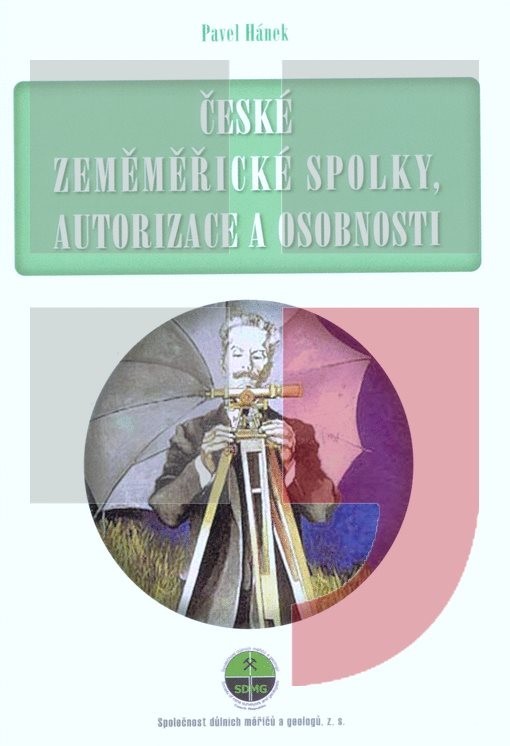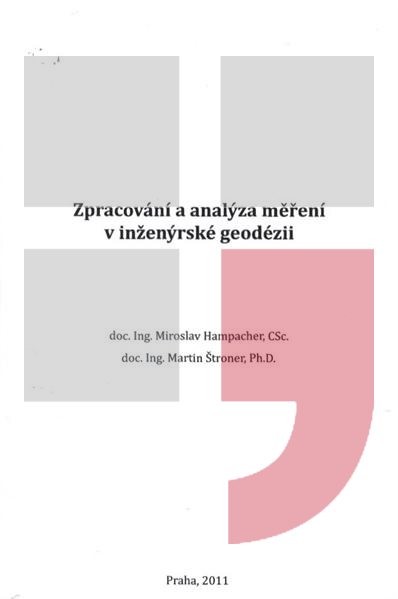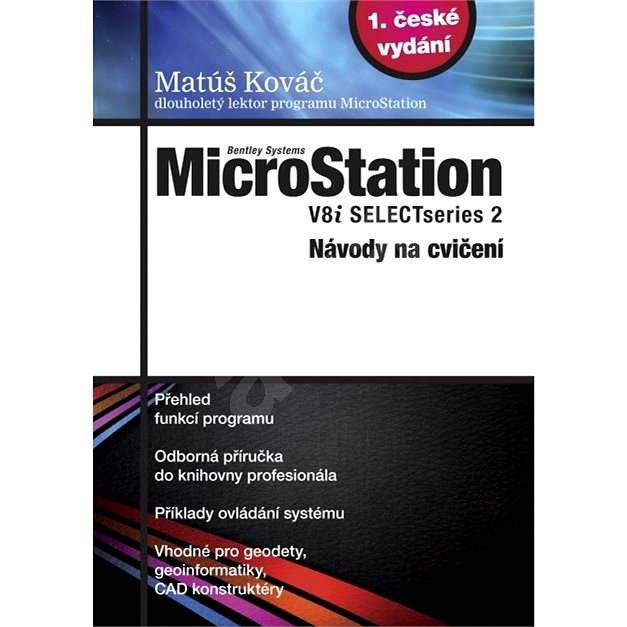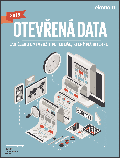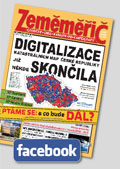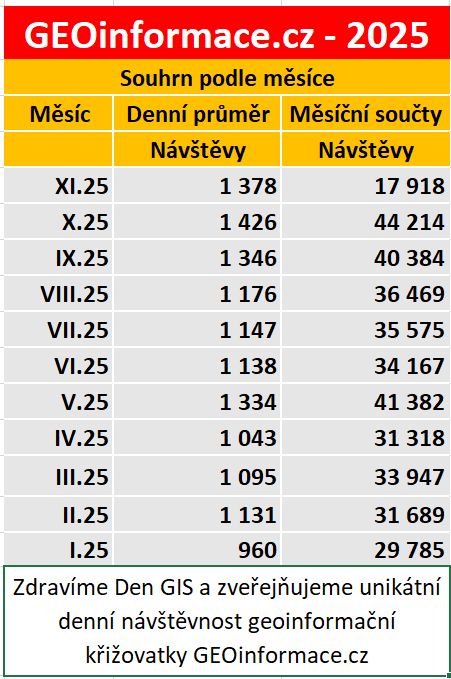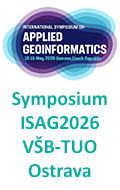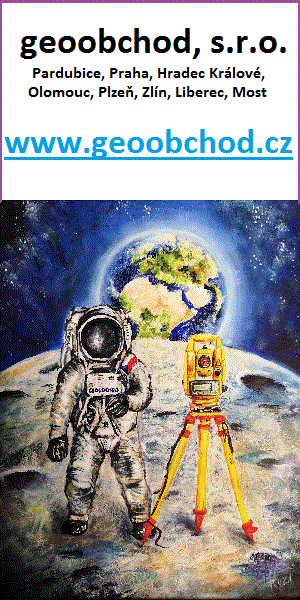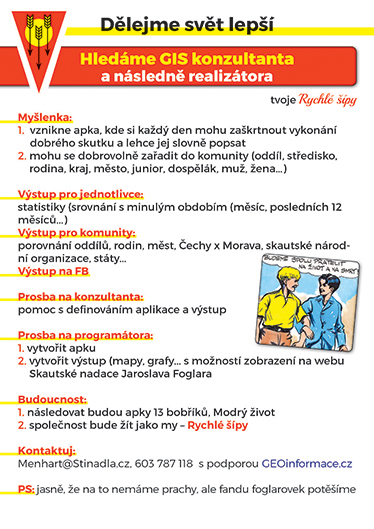zprávy
zdroje zpráv:20240117-Gako
17.1.2024 13:16 ČÚZK - předpisy a opatření Český úřad zeměměřický a katastrální zveřejnil novou aktualitu: Aktuální číslo Geodetického a kartografického obzoru (1/2024) je k dispozici ke stažení.20240117-Gako
17.1.2024 13:16 ČÚZK - aktuality v resortu Aktuální číslo Geodetického a kartografického obzoru (1/2024) je k dispozici ke stažení.20240313-Gako
17.1.2024 13:16 ČÚZK - předpisy a opatření Český úřad zeměměřický a katastrální zveřejnil novou aktualitu: Aktuální číslo Geodetického a kartografického obzoru (3/2024) je k dispozici ke stažení.20240117-Gako
17.1.2024 13:16 ČÚZK - aktuality v resortu Aktuální číslo Geodetického a kartografického obzoru (1/2024) je k dispozici ke stažení.20240117-Gako
17.1.2024 13:16 ČÚZK - předpisy a opatření Český úřad zeměměřický a katastrální zveřejnil novou aktualitu: Aktuální číslo Geodetického a kartografického obzoru (1/2024) je k dispozici ke stažení.20240216-Gako
17.1.2024 13:16 ČÚZK - předpisy a opatření Český úřad zeměměřický a katastrální zveřejnil novou aktualitu: Aktuální číslo Geodetického a kartografického obzoru (2/2024) je k dispozici ke stažení.
Nové číslo GaKO
17.1.2024 11:22
ÚGKK SR
Nové číslo časopisu Geodetického a Kartografického Obzoru 01/2024
Výroční zpráva dle zákona č. 106/1999 Sb. za rok 2023
17.1.2024 9:36 ČÚZK - předpisy a opatření Zeměměřický úřadvydává výroční zprávu úřadu za rok
2023
Výroční zpráva dle zákona č. 106/1999 Sb. za rok 2023
17.1.2024 9:36 Zeměměřický úřad Zeměměřický úřadvydává výroční zprávu úřadu za rok
2023
Výroční zpráva dle zákona č. 106/1999 Sb. za rok 2023
17.1.2024 9:36 ČÚZK /Urady/Zememericky-urad/Zpravy-ZU/Vyrocni-zpravy-ZU-souhrne-informace/Vyrocni-zprava-dle-zakona-c-106-1999-Sb-za-rok-(4)Výroční zpráva dle zákona č. 106/1999 Sb. za rok 2023
17.1.2024 9:36 Zeměměřický úřad Zeměměřický úřadvydává výroční zprávu úřadu za rok
2023
Zveřejnění obsahu informací poskytnutých na žádost dle zákona č. 106/1999 Sb. za rok 2024
17.1.2024 8:28 ČÚZK - předpisy a opatření Katastrální úřad pro Ústecký krajzveřejňuje obsah informace poskytnutých na žádost dle zákona č. 106/1999 Sb. za rok
2024
Zveřejnění obsahu informací poskytnutých na žádost dle zákona č. 106/1999 Sb. za rok 2024
17.1.2024 8:28 ČÚZK /Urady/Katastralni-urady/Katastralni-urady/Katastralni-urad-pro-Ustecky-kraj/Casto-hledane-informace/Poskytovani-informaci-106-1999-Sb/Zverejneni-obsahu-informaci-poskytnutych-na-za-(1)/Zverejneni-obsahu-informaci-poskytnutych-na-za-(6)Zveřejnění obsahu informací poskytnutých na žádost dle zákona č. 106/1999 Sb. za rok 2024
17.1.2024 8:28 ČÚZK - předpisy a opatření Katastrální úřad pro Ústecký krajzveřejňuje obsah informace poskytnutých na žádost dle zákona č. 106/1999 Sb. za rok
2024
Zveřejnění obsahu informací poskytnutých na žádost dle zákona č. 106/1999 Sb. za rok 2024
17.1.2024 8:28 ČÚZK /Urady/Katastralni-urady/Katastralni-urady/Katastralni-urad-pro-Ustecky-kraj/Casto-hledane-informace/Poskytovani-informaci-106-1999-Sb/Zverejneni-obsahu-informaci-poskytnutych-na-za-(1)/Zverejneni-obsahu-informaci-poskytnutych-na-za-(6)20240118 - volné místo – Odborný/vrchní referent v OPV KP Ústí n.L. na Katastrálním úřadu pro ÚK
17.1.2024 8:09 ČÚZK - předpisy a opatření Katastrální úřad pro Ústecký kraj - Katastrální pracoviště Ústí nad Labem zveřejnil novou aktualitu: Nabídka volného místa - Odborný / vrchní referent v oddělení právních vztahů k nemovitostem Katastrálního pracoviště Ústí nad Labem na Katastrálním úřadu pro Ústecký kraj20240118 - volné místo – Odborný/vrchní referent v OPV KP Ústí n.L. na Katastrálním úřadu pro ÚK
17.1.2024 8:09 ČÚZK /Urady/Katastralni-urady/Katastralni-urady/Katastralni-urad-pro-Ustecky-kraj/Katastralni-pracoviste/KP-Usti-nad-Labem/O-uradu/Aktuality/20240118-volne-misto-–-Odborny-vrchni-referent-v-O20240118 - volné místo – Odborný/vrchní referent v OPV KP Ústí n.L. na Katastrálním úřadu pro ÚK
17.1.2024 8:09 ČÚZK - předpisy a opatření Katastrální úřad pro Ústecký kraj - Katastrální pracoviště Ústí nad Labem zveřejnil novou aktualitu: Nabídka volného místa - Odborný / vrchní referent v oddělení právních vztahů k nemovitostem Katastrálního pracoviště Ústí nad Labem na Katastrálním úřadu pro Ústecký kraj20240118 - volné místo – Odborný/vrchní referent v OPV KP Ústí n.L. na Katastrálním úřadu pro ÚK
17.1.2024 8:09 ČÚZK /Urady/Katastralni-urady/Katastralni-urady/Katastralni-urad-pro-Ustecky-kraj/O-uradu/Aktuality/20240118-volne-misto-–-Odborny-vrchni-referent-v-OZveřejnění obsahu informací poskytnutých na žádost dle zákona č. 106/1999 Sb. za rok 2024
17.1.2024 8:08 ČÚZK /Urady/Katastralni-urady/Katastralni-urady/Katastralni-urad-pro-Moravskoslezsky-kraj/Casto-hledane-informace/Poskytovani-informaci-106-1999-Sb/Zverejneni-obsahu-informaci-poskytnutych-na-za-(1)/Zverejneni-obsahu-informaci-poskytnutych-na-za-(6)Zveřejnění obsahu informací poskytnutých na žádost dle zákona č. 106/1999 Sb. za rok 2024
17.1.2024 8:08 ČÚZK - předpisy a opatření Katastrální úřad pro Moravskoslezský krajzveřejňuje obsah informace poskytnutých na žádost dle zákona č. 106/1999 Sb. za rok
2024
Zveřejnění obsahu informací poskytnutých na žádost dle zákona č. 106/1999 Sb. za rok 2024
17.1.2024 8:08 ČÚZK - předpisy a opatření Katastrální úřad pro Moravskoslezský krajzveřejňuje obsah informace poskytnutých na žádost dle zákona č. 106/1999 Sb. za rok
2024
Zveřejnění obsahu informací poskytnutých na žádost dle zákona č. 106/1999 Sb. za rok 2024
17.1.2024 8:08 ČÚZK /Urady/Katastralni-urady/Katastralni-urady/Katastralni-urad-pro-Moravskoslezsky-kraj/Casto-hledane-informace/Poskytovani-informaci-106-1999-Sb/Zverejneni-obsahu-informaci-poskytnutych-na-za-(1)/Zverejneni-obsahu-informaci-poskytnutych-na-za-(6)Odborný / vrchní referent v oddělení právních vztahů k nemovitostem Katastrálního pracoviště Ústí na
17.1.2024 8:06 ČÚZK /Urady/Katastralni-urady/Katastralni-urady/Katastralni-urad-pro-Ustecky-kraj/Uredni-deska/Oznameni-a-jina-uredni-sdeleni/Volna-mista/DMS/Odborny-vrchni-referent-v-oddeleni-pravnich-vztahuOdborný / vrchní referent v oddělení právních vztahů k nemovitostem Katastrálního pracoviště Ústí na
17.1.2024 8:06 ČÚZK - volná místa Katastrální úřad pro Ústecký kraj Katastrální pracoviště Ústí nad Labem vypisuje výběrové řízení na místo Odborný / vrchní referent v oddělení právních vztahů k nemovitostem Katastrálního pracoviště Ústí naOdborný / vrchní referent v oddělení právních vztahů k nemovitostem Katastrálního pracoviště Ústí na
17.1.2024 8:06 ČÚZK - předpisy a opatření Katastrální úřad pro Ústecký kraj Katastrální pracoviště Ústí nad Labemvypisuje výběrové řízení na místo
Odborný / vrchní referent v oddělení právních vztahů k nemovitostem Katastrálního pracoviště Ústí nad Labem na Katastrálním úřadu pro Ústecký kraj
GaKO 1/2024
17.1.2024 6:24 GaKO GaKO 1/2024 MUŽÍK, F.: Využití herního enginu Unity pro vizualizaci zaniklé obce Zhůří v rozšířené realitěChallenge accepted
16.1.2024 14:41 European GNSS Agency
Think you have what it takes to solve some of today’s most pressing issues using EU Space? If your answer is an unequivocal ‘challenge accepted’, then the CASSINI Challenges are open for your prototypes and/or products.
The CASSINI Challenges aim to support the development of innovative commercial solutions – such as mobile apps or hardware-based solutions – that leverage EU Space data from Galileo and/or Copernicus.
Prototypes and products wanted
If the Idea Track is now closed with more than 100 proposals received, we are now looking for prototypes and products.
You can submit till 9 February your prototype under the "Submission of a Prototype" track. The application should showcase a tested solution in a relevant environment, detailing its typical use case, addressing customer needs, and highlighting the value proposition. The targeted Technology Readiness Level (TRL) for applications in this track is TRL4-TRL7.
For the Product Track, submission is expected on 19 April. More details can be found here.
Still EUR 800 thousand in prize money on the table!
Choose your challenge!
One of the three thematic challenges have to be addressed when proposing your prototype or your product:
- Next Generation Challenge: applicants are asked to leverage Galileo and Copernicus data to craft value adding solutions to improve the well-being, safety, security and connectivity of EU citizens.
- Sustainable Future Challenge: participants are tasked with developing innovative solutions for the conservation of ecosystems, sustainable agriculture and management of energy and resources.
- Emerging Technologies Challenge: innovators must develop disruptive solutions combining EU Space data with deep technologies such as Artificial Intelligence (AI), Quantum technologies (quantum computing, sensing, simulation, encryption, etc.), Blockchain technology and Extended Reality or the Metaverse (Augmented Reality (AR), Mixed Reality (MR), Virtual Reality (VR).
EUSPA’s got your back
For those ready to accept the challenge, you can find all the information you need – including the contest timeline, criteria, rules and application process – here.
If you’re still on the fence about applying, know this: throughout the entire competition, you’ll have the full support of EUSPA’s team of Market Development experts, who will offer advice and guidance to participants. You can also attend the webinar planned on January 23rd.
If that’s not enough to send you searching for the ‘apply now’ button, you’ll also have access to our treasure trove of tools, market intelligence and publications, including such titles as the EO and GNSS Market Report, GNSS User Technology Report, EU Space for Green Transformation and the GNSS Investment Report – amongst others.
Say it with us: ‘Challenge accepted’
Think you have what it takes to be the next SeaCras or Orioos?
Not only did these two past winners go on to become successful companies, today they’re making a real impact on society – all while using the data and services coming from EU Space.
Accept the CASSINI Challenge and apply today!
Media note: This feature can be republished without charge provided the European Union Agency for the Space Programme (EUSPA) is acknowledged as the source at the top or the bottom of the story. You must request permission before you use any of the photographs on the site. If you republish, we would be grateful if you could link back to the EUSPA website (http://www.euspa.europa.eu).
Informace o výsledcích kontrol dle § 26 zákona č. 255/2012 Sb. za rok 2023
16.1.2024 13:14 ČÚZK - předpisy a opatření Zeměměřický a katastrální inspektorát v Brněvydává informace o výsledcích kontrol dle § 26 zákona č. 255/2012 Sb. za rok
2023
Rozpočet úřadu za rok 2024
16.1.2024 10:45 ČÚZK - předpisy a opatření Katastrální úřad pro Zlínský krajvystavuje rozpočet úřadu za rok
2024
Rozpočet úřadu za rok 2024
16.1.2024 10:45 ČÚZK /Urady/Katastralni-urady/Katastralni-urady/Katastralni-urad-pro-Zlinsky-kraj/Rozpocet/Rozpocet-uradu-za-rok-2024Venkov 2024 [Knihovna geografie, byTopic]
16.1.2024 9:50 Katedra aplikované geoinformatiky a kartografie Přf UK Přijďte na tradiční seminář pořádaný Výzkumným centrem rurální geografie PřF UK.plán věcných úkolů na rok 2024
16.1.2024 8:24 ČÚZK /Urady/Katastralni-urady/Katastralni-urady/Katastralni-urad-pro-Ustecky-kraj/Katastralni-pracoviste/KP-Louny/O-uradu/Aktuality/plan-vecnych-ukolu-na-rok-2024plán věcných úkolů na rok 2024
16.1.2024 8:24 ČÚZK - předpisy a opatření Katastrální úřad pro Ústecký kraj - Katastrální pracoviště Louny zveřejnil novou aktualitu: Vážení klienti, oznamujeme Vám, že v roce 2024 budou postupně probíhat revize údajů katastru nemovitostí v katastrálních územích Divice, Brloh, Nová Ves u Hříškova, Bedřichovice, Úherce u Panenského Týnce, Vinařice u Loun, Úlovice. V 2. pololetí budou zahájeny revize v k.ú. Hříškov, Panenský Týnec, Peruc, Hřivčice, Žerotín, Telce. Předmětem revize jsou zejména zápisy staveb, druhu a způsobu využití pozemků, kdy výsledkem by mělo být dosažení co nejlepšího souladu katastru nemovitostí se skutečným stavem v terénu. O přesnějším termínu zahájení revize budete informováni obecním úřadem způsobem v místě obvyklém.V roce 2024 zároveň budou dokončovány měřické práce na novém mapování v k.ú. Horní Ročov, kde letos bude vyhlášena platnost obnoveného operátu. O příslušných termínech budete informováni dopisem nebo veřejnou vyhláškou na úřední desce obce. V k.ú. Libčeves bude pokračovat nové mapování - etapa zjišťování průběhu hranic a měřické práce.
plán věcných úkolů na rok 2024
16.1.2024 8:24 ČÚZK - předpisy a opatření Katastrální úřad pro Ústecký kraj - Katastrální pracoviště Louny zveřejnil novou aktualitu: Vážení klienti, oznamujeme Vám, že v roce 2024 budou postupně probíhat revize údajů katastru nemovitostí v katastrálních územích Divice, Brloh, Nová Ves u Hříškova, Bedřichovice, Úherce u Panenského Týnce, Vinařice u Loun, Úlovice. V 2. pololetí budou zahájeny revize v k.ú. Hříškov, Panenský Týnec, Peruc, Hřivčice, Žerotín, Telce. Předmětem revize jsou zejména zápisy staveb, druhu a způsobu využití pozemků, kdy výsledkem by mělo být dosažení co nejlepšího souladu katastru nemovitostí se skutečným stavem v terénu. O přesnějším termínu zahájení revize budete informováni obecním úřadem způsobem v místě obvyklém.V roce 2024 zároveň budou dokončovány měřické práce na novém mapování v k.ú. Horní Ročov, kde letos bude vyhlášena platnost obnoveného operátu. O příslušných termínech budete informováni dopisem nebo veřejnou vyhláškou na úřední desce obce. V k.ú. Libčeves bude pokračovat nové mapování - etapa zjišťování průběhu hranic a měřické práce.
Bližší informace najdete zde:
.png.aspx)
Zveřejnění obsahu informací poskytnutých na žádost dle zákona č. 106/1999 Sb. za rok 2024
15.1.2024 13:15 ČÚZK /Urady/Katastralni-urady/Katastralni-urady/Katastralni-urad-pro-Vysocinu/Casto-hledane-informace/Poskytovani-informaci-106-1999-Sb/Zverejneni-obsahu-informaci-poskytnutych-na-za-(1)/Zverejneni-obsahu-informaci-poskytnutych-na-za-(6)Zveřejnění obsahu informací poskytnutých na žádost dle zákona č. 106/1999 Sb. za rok 2024
15.1.2024 13:15 ČÚZK - předpisy a opatření Katastrální úřad pro Vysočinuzveřejňuje obsah informace poskytnutých na žádost dle zákona č. 106/1999 Sb. za rok
2024
Zveřejnění obsahu informací poskytnutých na žádost dle zákona č. 106/1999 Sb. za rok 2024
15.1.2024 13:15 ČÚZK /Urady/Katastralni-urady/Katastralni-urady/Katastralni-urad-pro-Vysocinu/Casto-hledane-informace/Poskytovani-informaci-106-1999-Sb/Zverejneni-obsahu-informaci-poskytnutych-na-za-(1)/Zverejneni-obsahu-informaci-poskytnutych-na-za-(6)Zveřejnění obsahu informací poskytnutých na žádost dle zákona č. 106/1999 Sb. za rok 2024
15.1.2024 13:15 ČÚZK - předpisy a opatření Katastrální úřad pro Vysočinuzveřejňuje obsah informace poskytnutých na žádost dle zákona č. 106/1999 Sb. za rok
2024
Výběrové řízení
15.1.2024 11:52 ČÚZK - předpisy a opatření Katastrální úřad pro Plzeňský kraj - Katastrální pracoviště Klatovy zveřejnil novou aktualitu: Ředitelka Katastrálního úřadu pro Plzeňský kraj jako služební orgán příslušný podle § 10 odst. 1 písm. f) zákona č. 234/2014 Sb., o státní službě, ve znění pozdějších předpisů, vyhlašuje výběrové řízení na služební místo rada/odborný rada - rozhodování o povolení vkladu, RPV0603, oddělení právních vztahů k nemovitostem, Katastrální úřad pro Plzeňský kraj, Katastrální pracoviště Klatovy.Na služebním místě je státní služba (dále jen „služba“) vykonávána v oboru služby 55. Zeměměřictví a katastr nemovitostí.
Služební místo je zařazeno podle přílohy č. 1 k zákonu o státní službě do 12. platové třídy.
Služba na služebním místě bude vykonávána ve služebním poměru na dobu neurčitou.
Předpokládaným dnem nástupu do služby na služebním místě je 1. březen 2024.
Délka stanovené týdenní služební doby je 40 hodin.
Na služebním místě se umožňuje služba se zkrácenou služební dobou („kratší úvazek“).
Rada/odborný rada v oddělení právním č.1 na Katastrálním pracovišti Brno - město
15.1.2024 11:16 ČÚZK - předpisy a opatření Katastrální úřad pro Jihomoravský krajvypisuje výběrové řízení na místo
Rada/odborný rada v oddělení právním č.1 na Katastrálním pracovišti Brno - město
Rada/odborný rada v oddělení právním č.1 na Katastrálním pracovišti Brno - město
15.1.2024 11:16 ČÚZK /Urady/Katastralni-urady/Katastralni-urady/Katastralni-urad-pro-Jihomoravsky-kraj/Uredni-deska/Oznameni-a-jina-uredni-sdeleni/Volna-mista/DMS/Rada-odborny-rada-v-oddeleni-pravni-c-1-na-KatastrRada/odborný rada v oddělení právním č.1 na Katastrálním pracovišti Brno - město
15.1.2024 11:16 ČÚZK - volná místa Katastrální úřad pro Jihomoravský kraj vypisuje výběrové řízení na místo Rada/odborný rada v oddělení právním č.1 na Katastrálním pracovišti Brno - městoRozpočet úřadu za rok 2024
15.1.2024 10:10 ČÚZK - předpisy a opatření Katastrální úřad pro Vysočinuvystavuje rozpočet úřadu za rok
2024
Rozpočet úřadu za rok 2024
15.1.2024 10:10 ČÚZK /Urady/Katastralni-urady/Katastralni-urady/Katastralni-urad-pro-Vysocinu/Rozpocet/Rozpocet-uradu-za-rok-2024Výroční zpráva dle zákona č. 106/1999 Sb. za rok 2023
15.1.2024 9:32 ČÚZK /Urady/Katastralni-urady/Katastralni-urady/Katastralni-urad-pro-Vysocinu/Vyrocni-zpravy/Vyrocni-zprava-dle-zakona-c-106-1999-Sb-za-rok-(4)Výroční zpráva dle zákona č. 106/1999 Sb. za rok 2023
15.1.2024 9:32 ČÚZK - předpisy a opatření Katastrální úřad pro Vysočinuvydává výroční zprávu úřadu za rok
2023
Krátká lednová sleva 15 % na Autodesk AutoCAD, AutoCAD LT a Revit LT Suite
15.1.2024 0:00 Arkance SystemsNejpoužívanější produkty výhodně - jen do 18. 1. Se všemi ARKANCE bonusy a navíc unikátní e-learning "Základy AutoCAD / AutoCAD LT".
Zpráva Krátká lednová sleva 15 % na Autodesk AutoCAD, AutoCAD LT a Revit LT Suite pochází z arkance-systems.cz.
Blesková akce AutoCAD licencí - sleva 15 %
15.1.2024 0:00 Adeon
Autodesk již tradičně vyhlásil časově omezenou slevovou nabídku (flash sale) vybraných produktů. Od 15.1. do 18.1. máte možnost si jednoleté a […]
The post Blesková akce AutoCAD licencí - sleva 15 % appeared first on Adeon CZ.
Blesková akce AutoCAD licencí - sleva 15 %
15.1.2024 0:00 Adeon
Autodesk již tradičně vyhlásil časově omezenou slevovou nabídku (flash sale) vybraných produktů. Od 15.1. do 18.1. máte možnost si jednoleté a […]
The post Blesková akce AutoCAD licencí - sleva 15 % appeared first on Adeon CZ.
TurboCAD Designer 28 CZ + přes 30 miliónů CAD Symbolů
12.1.2024 20:07 ŠPINAR - softwarePřipravili jsme pro Vás další spojení TurboCAD Designer + CAD Symbols v akční ceně.
The post TurboCAD Designer 28 CZ + přes 30 miliónů CAD Symbolů appeared first on ŠPINAR – software.
odborný /vrchní referent – revize katastrálního operátu
12.1.2024 17:44 ČÚZK - předpisy a opatření Katastrální úřad pro hlavní město Prahu zveřejnil novou aktualitu: Ředitelka úřadu vyhlašuje výběrové řízení na pozici:odborný /vrchní referent – revize katastrálního operátu
odborný /vrchní referent – revize katastrálního operátu
12.1.2024 17:44 ČÚZK /Urady/Katastralni-urady/Katastralni-urady/Katastralni-urad-pro-hlavni-mesto-Prahu/O-uradu/Aktuality/odborny-vrchni-referent-–-revize-katastralniho-opeodborný /vrchní referent – revize katastrálního operátu
12.1.2024 17:34 ČÚZK - volná místa Katastrální úřad pro hlavní město Prahu vypisuje výběrové řízení na místo odborný /vrchní referent – revize katastrálního operátuodborný /vrchní referent – revize katastrálního operátu
12.1.2024 17:34 ČÚZK /Urady/Katastralni-urady/Katastralni-urady/Katastralni-urad-pro-hlavni-mesto-Prahu/Uredni-deska/Oznameni-a-jina-uredni-sdeleni/Volna-mista/odborny-vrchni-referent-–-revize-katastralniho-(2)odborný /vrchní referent – revize katastrálního operátu
12.1.2024 17:34 ČÚZK - předpisy a opatření Katastrální úřad pro hlavní město Prahuvypisuje výběrové řízení na místo
odborný /vrchní referent – revize katastrálního operátu
20240112 - plán revizí a obnovy katastrálního operátu v r.2024
12.1.2024 12:55 ČÚZK /Urady/Katastralni-urady/Katastralni-urady/Katastralni-urad-pro-Ustecky-kraj/Katastralni-pracoviste/KP-Usti-nad-Labem/O-uradu/Aktuality/20240112-plan-revizi-a-obnovy-katastralniho-operat20240112 - plán revizí a obnovy katastrálního operátu v r.2024
12.1.2024 12:55 ČÚZK - předpisy a opatření Katastrální úřad pro Ústecký kraj - Katastrální pracoviště Ústí nad Labem zveřejnil novou aktualitu: Vážením klienti,oznamujeme Vám, že v roce 2024 budou postupně probíhat revize katastru nemovitostí v katastrálních územích (dále jen „k.ú.“) Leština u Malého Března (intravilán), Lhota pod Pannou (intravilán), Malé Březno nad Labem (celé k.ú.), Povrly (celé k.ú.), Suletice (intravilán), Vitín u Malého Března (celé k.ú.), Vyklice (celé k.ú.) a Zalužany u Vyklic (celé k.ú.). Při revizi údajů katastru katastrální úřad reviduje soulad údajů katastru se skutečným stavem v terénu, zejména pak zápisy staveb, druhu a způsobu využití pozemků, kdy výsledkem by mělo být dosažení co nejlepšího souladu.
V rámci obnovy katastrálního operátu novým mapováním bude za účasti vlastníků v roce 2024 probíhat zjišťování průběhu hranic a revize v k.ú. Knínice u Libouchce.
V roce 2024 bude dokončena obnova katastrálního operátu novým mapováním v k.ú. Stebno u Dubic, Liboňov a Roudníky.
A dále bude v roce 2024 dokončena obnova operátu na podkladě výsledků pozemkových úprav v v k.ú.Tašov.
20240112 - plán revizí a obnovy katastrálního operátu v r.2024
12.1.2024 12:55 ČÚZK - předpisy a opatření Katastrální úřad pro Ústecký kraj - Katastrální pracoviště Ústí nad Labem zveřejnil novou aktualitu: Vážením klienti,oznamujeme Vám, že v roce 2024 budou postupně probíhat revize katastru nemovitostí v katastrálních územích (dále jen „k.ú.“) Leština u Malého Března (intravilán), Lhota pod Pannou (intravilán), Malé Březno nad Labem (celé k.ú.), Povrly (celé k.ú.), Suletice (intravilán), Vitín u Malého Března (celé k.ú.), Vyklice (celé k.ú.) a Zalužany u Vyklic (celé k.ú.). Při revizi údajů katastru katastrální úřad reviduje soulad údajů katastru se skutečným stavem v terénu, zejména pak zápisy staveb, druhu a způsobu využití pozemků, kdy výsledkem by mělo být dosažení co nejlepšího souladu.
V rámci obnovy katastrálního operátu novým mapováním bude za účasti vlastníků v roce 2024 probíhat zjišťování průběhu hranic a revize v k.ú. Knínice u Libouchce.
V roce 2024 bude dokončena obnova katastrálního operátu novým mapováním v k.ú. Stebno u Dubic, Liboňov a Roudníky.
A dále bude v roce 2024 dokončena obnova operátu na podkladě výsledků pozemkových úprav v k.ú.Tašov.
20240112_Odborný referent oddělení právních vztahů k nemovitostem - 00225
12.1.2024 10:56 ČÚZK - předpisy a opatření Katastrální úřad pro Středočeský kraj - Katastrální pracoviště Příbram Vyhlášení výběrového řízení: Odborný referent oddělení právních vztahů k nemovitostem V části "Úřední deska", v sekci "Oznámení a jiná úřední sdělení" bylo vystaveno "Oznámení o vyhlášení výběrového řízení na obsazení služebního místa Odborný referent oddělení právních vztahů k nemovitostem - 00225"20240112_Odborný referent oddělení právních vztahů k nemovitostem - 00225
12.1.2024 10:56 ČÚZK /Urady/Katastralni-urady/Katastralni-urady/Katastralni-urad-pro-Stredocesky-kraj/Katastralni-pracoviste/KP-Pribram/O-uradu/Aktuality/20230910_Odborny-vrchni-referent-oddeleni-prav-(3)Odborný referent oddělení právních vztahů k nemovitostem - 00225
12.1.2024 10:56 ČÚZK - předpisy a opatření Katastrální úřad pro Středočeský kraj Katastrální pracoviště Příbramvypisuje výběrové řízení na místo
Odborný referent oddělení právních vztahů k nemovitostem - 00225
Odborný referent oddělení právních vztahů k nemovitostem - 00225
12.1.2024 10:56 ČÚZK /Urady/Katastralni-urady/Katastralni-urady/Katastralni-urad-pro-Stredocesky-kraj/Uredni-deska/Oznameni-a-jina-uredni-sdeleni/Volna-mista/DMS/Odborny-referent-oddeleni-pravnich-vztahu-k-ne-(1)Odborný referent oddělení právních vztahů k nemovitostem - 00225
12.1.2024 10:56 ČÚZK - předpisy a opatření Katastrální úřad pro Středočeský kraj - Katastrální pracoviště Příbramvypisuje výběrové řízení na místo
Odborný referent oddělení právních vztahů k nemovitostem - 00225
Odborný referent oddělení právních vztahů k nemovitostem - 00225
12.1.2024 10:56 ČÚZK - volná místa Katastrální úřad pro Středočeský kraj - Katastrální pracoviště Příbram vypisuje výběrové řízení na místo Odborný referent oddělení právních vztahů k nemovitostem - 00225Odborný referent oddělení právních vztahů k nemovitostem - 00225
12.1.2024 10:56 ČÚZK - volná místa Katastrální úřad pro Středočeský kraj Katastrální pracoviště Příbram vypisuje výběrové řízení na místo Odborný referent oddělení právních vztahů k nemovitostem - 0022520240112_Odborný referent oddělení právních vztahů k nemovitostem
12.1.2024 10:44 ČÚZK /Urady/Katastralni-urady/Katastralni-urady/Katastralni-urad-pro-Stredocesky-kraj/Katastralni-pracoviste/KP-Pribram/O-uradu/Aktuality/20230910_Odborny-vrchni-referent-oddeleni-prav-(2)20240112_Odborný referent oddělení právních vztahů k nemovitostem
12.1.2024 10:44 ČÚZK - předpisy a opatření Katastrální úřad pro Středočeský kraj - Katastrální pracoviště Příbram Vyhlášení výběrového řízení: Odborný referent oddělení právních vztahů k nemovitostem V části "Úřední deska", v sekci "Oznámení a jiná úřední sdělení" bylo vystaveno "Oznámení o vyhlášení výběrového řízení na obsazení služebního místa Odborný referent oddělení právních vztahů k nemovitostem"Odborný referent oddělení právních vztahů k nemovitostem
12.1.2024 10:42 ČÚZK - předpisy a opatření Katastrální úřad pro Středočeský kraj - Katastrální pracoviště Příbramvypisuje výběrové řízení na místo
Odborný referent oddělení právních vztahů k nemovitostem
Odborný referent oddělení právních vztahů k nemovitostem
12.1.2024 10:42 ČÚZK - volná místa Katastrální úřad pro Středočeský kraj Katastrální pracoviště Příbram vypisuje výběrové řízení na místo Odborný referent oddělení právních vztahů k nemovitostemOdborný referent oddělení právních vztahů k nemovitostem
12.1.2024 10:42 ČÚZK - volná místa Katastrální úřad pro Středočeský kraj - Katastrální pracoviště Příbram vypisuje výběrové řízení na místo Odborný referent oddělení právních vztahů k nemovitostemOdborný referent oddělení právních vztahů k nemovitostem
12.1.2024 10:42 ČÚZK - předpisy a opatření Katastrální úřad pro Středočeský kraj Katastrální pracoviště Příbramvypisuje výběrové řízení na místo
Odborný referent oddělení právních vztahů k nemovitostem
Media invitation: Last chance to see the EarthCARE satellite
12.1.2024 10:36 ESA Observing the Earth
Media invitation: Last chance to see the EarthCARE satellite
20240112_Investiční referent OHS – vrchní referent / rada kanceláře ředitele
12.1.2024 10:03 ČÚZK /Urady/Katastralni-urady/Katastralni-urady/Katastralni-urad-pro-Stredocesky-kraj/O-uradu/Aktuality/20210922_Odborny-referent-oddeleni-aktualizac-(3)20240112_Investiční referent OHS – vrchní referent / rada kanceláře ředitele
12.1.2024 10:03 ČÚZK - předpisy a opatření Katastrální úřad pro Středočeský kraj Vyhlášení výběrového řízení: Investiční referent OHS – vrchní referent / rada V části "Úřední deska", v sekci "Oznámení a jiná úřední sdělení" bylo vystaveno "Oznámení o vyhlášení výběrového řízení na obsazení služebního místa Investiční referent OHS – vrchní referent / rada kanceláře ředitele"Investiční referent OHS – vrchní referent / rada kanceláře ředitele
12.1.2024 10:01 ČÚZK - předpisy a opatření Katastrální úřad pro Středočeský kraj kancelář úřaduvypisuje výběrové řízení na místo
Investiční referent OHS – vrchní referent / rada kanceláře ředitele
Investiční referent OHS – vrchní referent / rada kanceláře ředitele
12.1.2024 10:01 ČÚZK - volná místa Katastrální úřad pro Středočeský kraj kancelář úřadu vypisuje výběrové řízení na místo Investiční referent OHS – vrchní referent / rada kanceláře řediteleInvestiční referent OHS – vrchní referent / rada kanceláře ředitele
12.1.2024 10:01 ČÚZK /Urady/Katastralni-urady/Katastralni-urady/Katastralni-urad-pro-Stredocesky-kraj/Uredni-deska/Oznameni-a-jina-uredni-sdeleni/Volna-mista/DMS/Investicni-referent-OHS-–-vrchni-referent-rada-kanAktualizace služby WMTS ZABAGED® - polohopis
12.1.2024 10:00 ČÚZK - Geoportál Aktualizace služby WMTS ZABAGED® - polohopisProhlížecí služba z předpřipravených mapových dlaždic WMTS ZABAGED® - polohopis, vytvořená za účelem využití datové sady ZABAGED® - polohopis jako podkladové mapy s rychlým překreslováním, již poskytuje veškeré změny po poslední pravidelné čtvrtletní aktualizaci dat.
Již dříve (souběžně s aktualizací dat) byla aktualizována dynamická prohlížecí služba ZABAGED® - polohopis poskytující obraz dat přímo z publikační databáze, včetně možnosti vypínání vrstev, dotazů na atributy a stahování objektů ve formátu GeoJSON.
Aktualizace služby WMTS ZABAGED® - polohopis
12.1.2024 10:00 ČÚZK - Geoportál Aktualizace služby WMTS ZABAGED® - polohopisProhlížecí služba z předpřipravených mapových dlaždic WMTS ZABAGED® - polohopis, vytvořená za účelem využití datové sady ZABAGED® - polohopis jako podkladové mapy s rychlým překreslováním, již poskytuje veškeré změny po poslední pravidelné čtvrtletní aktualizaci dat.
Již dříve (souběžně s aktualizací dat) byla aktualizována dynamická prohlížecí služba ZABAGED® - polohopis poskytující obraz dat přímo z publikační databáze, včetně možnosti vypínání vrstev, dotazů na atributy a stahování objektů ve formátu GeoJSON.
Aktualizace služby WMTS ZABAGED® - polohopis
12.1.2024 10:00 ČÚZK - Geoportál Aktualizace služby WMTS ZABAGED® - polohopisProhlížecí služba z předpřipravených mapových dlaždic WMTS ZABAGED® - polohopis, vytvořená za účelem využití datové sady ZABAGED® - polohopis jako podkladové mapy s rychlým překreslováním, již poskytuje veškeré změny po poslední pravidelné čtvrtletní aktualizaci dat.
Již dříve (souběžně s aktualizací dat) byla aktualizována dynamická prohlížecí služba ZABAGED® - polohopis poskytující obraz dat přímo z publikační databáze, včetně možnosti vypínání vrstev, dotazů na atributy a stahování objektů ve formátu GeoJSON.
Aktualizace služby WMTS ZABAGED® - polohopis
12.1.2024 10:00 ČÚZK - Geoportál Aktualizace služby WMTS ZABAGED® - polohopisProhlížecí služba z předpřipravených mapových dlaždic WMTS ZABAGED® - polohopis, vytvořená za účelem využití datové sady ZABAGED® - polohopis jako podkladové mapy s rychlým překreslováním, již poskytuje veškeré změny po poslední pravidelné čtvrtletní aktualizaci dat.
Již dříve (souběžně s aktualizací dat) byla aktualizována dynamická prohlížecí služba ZABAGED® - polohopis poskytující obraz dat přímo z publikační databáze, včetně možnosti vypínání vrstev, dotazů na atributy a stahování objektů ve formátu GeoJSON.
Aktualizace služby WMTS ZABAGED® - polohopis
12.1.2024 10:00 ČÚZK - Geoportál Aktualizace služby WMTS ZABAGED® - polohopisProhlížecí služba z předpřipravených mapových dlaždic WMTS ZABAGED® - polohopis, vytvořená za účelem využití datové sady ZABAGED® - polohopis jako podkladové mapy s rychlým překreslováním, již poskytuje veškeré změny po poslední pravidelné čtvrtletní aktualizaci dat.
Již dříve (souběžně s aktualizací dat) byla aktualizována dynamická prohlížecí služba ZABAGED® - polohopis poskytující obraz dat přímo z publikační databáze, včetně možnosti vypínání vrstev, dotazů na atributy a stahování objektů ve formátu GeoJSON.
Aktualizace služby WMTS ZABAGED® - polohopis
12.1.2024 10:00 ČÚZK - Geoportál Aktualizace služby WMTS ZABAGED® - polohopisProhlížecí služba z předpřipravených mapových dlaždic WMTS ZABAGED® - polohopis, vytvořená za účelem využití datové sady ZABAGED® - polohopis jako podkladové mapy s rychlým překreslováním, již poskytuje veškeré změny po poslední pravidelné čtvrtletní aktualizaci dat.
Již dříve (souběžně s aktualizací dat) byla aktualizována dynamická prohlížecí služba ZABAGED® - polohopis poskytující obraz dat přímo z publikační databáze, včetně možnosti vypínání vrstev, dotazů na atributy a stahování objektů ve formátu GeoJSON.
Aktualizace služby WMTS ZABAGED® - polohopis
12.1.2024 10:00 ČÚZK - Geoportál Aktualizace služby WMTS ZABAGED® - polohopisProhlížecí služba z předpřipravených mapových dlaždic WMTS ZABAGED® - polohopis, vytvořená za účelem využití datové sady ZABAGED® - polohopis jako podkladové mapy s rychlým překreslováním, již poskytuje veškeré změny po poslední pravidelné čtvrtletní aktualizaci dat.
Již dříve (souběžně s aktualizací dat) byla aktualizována dynamická prohlížecí služba ZABAGED® - polohopis poskytující obraz dat přímo z publikační databáze, včetně možnosti vypínání vrstev, dotazů na atributy a stahování objektů ve formátu GeoJSON.
Aktualizace služby WMTS ZABAGED® - polohopis
12.1.2024 10:00 ČÚZK - Geoportál Aktualizace služby WMTS ZABAGED® - polohopisProhlížecí služba z předpřipravených mapových dlaždic WMTS ZABAGED® - polohopis, vytvořená za účelem využití datové sady ZABAGED® - polohopis jako podkladové mapy s rychlým překreslováním, již poskytuje veškeré změny po poslední pravidelné čtvrtletní aktualizaci dat.
Již dříve (souběžně s aktualizací dat) byla aktualizována dynamická prohlížecí služba ZABAGED® - polohopis poskytující obraz dat přímo z publikační databáze, včetně možnosti vypínání vrstev, dotazů na atributy a stahování objektů ve formátu GeoJSON.
Aktualizace služby WMTS ZABAGED® - polohopis
12.1.2024 10:00 ČÚZK - Geoportál Aktualizace služby WMTS ZABAGED® - polohopisProhlížecí služba z předpřipravených mapových dlaždic WMTS ZABAGED® - polohopis, vytvořená za účelem využití datové sady ZABAGED® - polohopis jako podkladové mapy s rychlým překreslováním, již poskytuje veškeré změny po poslední pravidelné čtvrtletní aktualizaci dat.
Již dříve (souběžně s aktualizací dat) byla aktualizována dynamická prohlížecí služba ZABAGED® - polohopis poskytující obraz dat přímo z publikační databáze, včetně možnosti vypínání vrstev, dotazů na atributy a stahování objektů ve formátu GeoJSON.
Aktualizace služby WMTS ZABAGED® - polohopis
12.1.2024 10:00 ČÚZK - Geoportál Aktualizace služby WMTS ZABAGED® - polohopisProhlížecí služba z předpřipravených mapových dlaždic WMTS ZABAGED® - polohopis, vytvořená za účelem využití datové sady ZABAGED® - polohopis jako podkladové mapy s rychlým překreslováním, již poskytuje veškeré změny po poslední pravidelné čtvrtletní aktualizaci dat.
Již dříve (souběžně s aktualizací dat) byla aktualizována dynamická prohlížecí služba ZABAGED® - polohopis poskytující obraz dat přímo z publikační databáze, včetně možnosti vypínání vrstev, dotazů na atributy a stahování objektů ve formátu GeoJSON.
Aktualizace služby WMTS ZABAGED® - polohopis
12.1.2024 10:00 ČÚZK - Geoportál Aktualizace služby WMTS ZABAGED® - polohopisProhlížecí služba z předpřipravených mapových dlaždic WMTS ZABAGED® - polohopis, vytvořená za účelem využití datové sady ZABAGED® - polohopis jako podkladové mapy s rychlým překreslováním, již poskytuje veškeré změny po poslední pravidelné čtvrtletní aktualizaci dat.
Již dříve (souběžně s aktualizací dat) byla aktualizována dynamická prohlížecí služba ZABAGED® - polohopis poskytující obraz dat přímo z publikační databáze, včetně možnosti vypínání vrstev, dotazů na atributy a stahování objektů ve formátu GeoJSON.
Aktualizace služby WMTS ZABAGED® - polohopis
12.1.2024 10:00 ČÚZK - Geoportál Aktualizace služby WMTS ZABAGED® - polohopisProhlížecí služba z předpřipravených mapových dlaždic WMTS ZABAGED® - polohopis, vytvořená za účelem využití datové sady ZABAGED® - polohopis jako podkladové mapy s rychlým překreslováním, již poskytuje veškeré změny po poslední pravidelné čtvrtletní aktualizaci dat.
Již dříve (souběžně s aktualizací dat) byla aktualizována dynamická prohlížecí služba ZABAGED® - polohopis poskytující obraz dat přímo z publikační databáze, včetně možnosti vypínání vrstev, dotazů na atributy a stahování objektů ve formátu GeoJSON.
Aktualizace služby WMTS ZABAGED® - polohopis
12.1.2024 10:00 ČÚZK - Geoportál Aktualizace služby WMTS ZABAGED® - polohopisProhlížecí služba z předpřipravených mapových dlaždic WMTS ZABAGED® - polohopis, vytvořená za účelem využití datové sady ZABAGED® - polohopis jako podkladové mapy s rychlým překreslováním, již poskytuje veškeré změny po poslední pravidelné čtvrtletní aktualizaci dat.
Již dříve (souběžně s aktualizací dat) byla aktualizována dynamická prohlížecí služba ZABAGED® - polohopis poskytující obraz dat přímo z publikační databáze, včetně možnosti vypínání vrstev, dotazů na atributy a stahování objektů ve formátu GeoJSON.
Aktualizace služby WMTS ZABAGED® - polohopis
12.1.2024 10:00 ČÚZK - Geoportál Aktualizace služby WMTS ZABAGED® - polohopisProhlížecí služba z předpřipravených mapových dlaždic WMTS ZABAGED® - polohopis, vytvořená za účelem využití datové sady ZABAGED® - polohopis jako podkladové mapy s rychlým překreslováním, již poskytuje veškeré změny po poslední pravidelné čtvrtletní aktualizaci dat.
Již dříve (souběžně s aktualizací dat) byla aktualizována dynamická prohlížecí služba ZABAGED® - polohopis poskytující obraz dat přímo z publikační databáze, včetně možnosti vypínání vrstev, dotazů na atributy a stahování objektů ve formátu GeoJSON.
Aktualizace služby WMTS ZABAGED® - polohopis
12.1.2024 10:00 ČÚZK - Geoportál Aktualizace služby WMTS ZABAGED® - polohopisProhlížecí služba z předpřipravených mapových dlaždic WMTS ZABAGED® - polohopis, vytvořená za účelem využití datové sady ZABAGED® - polohopis jako podkladové mapy s rychlým překreslováním, již poskytuje veškeré změny po poslední pravidelné čtvrtletní aktualizaci dat.
Již dříve (souběžně s aktualizací dat) byla aktualizována dynamická prohlížecí služba ZABAGED® - polohopis poskytující obraz dat přímo z publikační databáze, včetně možnosti vypínání vrstev, dotazů na atributy a stahování objektů ve formátu GeoJSON.
Aktualizace služby WMTS ZABAGED® - polohopis
12.1.2024 10:00 ČÚZK - Geoportál Aktualizace služby WMTS ZABAGED® - polohopisProhlížecí služba z předpřipravených mapových dlaždic WMTS ZABAGED® - polohopis, vytvořená za účelem využití datové sady ZABAGED® - polohopis jako podkladové mapy s rychlým překreslováním, již poskytuje veškeré změny po poslední pravidelné čtvrtletní aktualizaci dat.
Již dříve (souběžně s aktualizací dat) byla aktualizována dynamická prohlížecí služba ZABAGED® - polohopis poskytující obraz dat přímo z publikační databáze, včetně možnosti vypínání vrstev, dotazů na atributy a stahování objektů ve formátu GeoJSON.
Aktualizace služby WMTS ZABAGED® - polohopis
12.1.2024 10:00 ČÚZK - Geoportál Aktualizace služby WMTS ZABAGED® - polohopisProhlížecí služba z předpřipravených mapových dlaždic WMTS ZABAGED® - polohopis, vytvořená za účelem využití datové sady ZABAGED® - polohopis jako podkladové mapy s rychlým překreslováním, již poskytuje veškeré změny po poslední pravidelné čtvrtletní aktualizaci dat.
Již dříve (souběžně s aktualizací dat) byla aktualizována dynamická prohlížecí služba ZABAGED® - polohopis poskytující obraz dat přímo z publikační databáze, včetně možnosti vypínání vrstev, dotazů na atributy a stahování objektů ve formátu GeoJSON.
Aktualizace služby WMTS ZABAGED® - polohopis
12.1.2024 10:00 ČÚZK - Geoportál Aktualizace služby WMTS ZABAGED® - polohopisProhlížecí služba z předpřipravených mapových dlaždic WMTS ZABAGED® - polohopis, vytvořená za účelem využití datové sady ZABAGED® - polohopis jako podkladové mapy s rychlým překreslováním, již poskytuje veškeré změny po poslední pravidelné čtvrtletní aktualizaci dat.
Již dříve (souběžně s aktualizací dat) byla aktualizována dynamická prohlížecí služba ZABAGED® - polohopis poskytující obraz dat přímo z publikační databáze, včetně možnosti vypínání vrstev, dotazů na atributy a stahování objektů ve formátu GeoJSON.
Aktualizace služby WMTS ZABAGED® - polohopis
12.1.2024 10:00 ČÚZK - Geoportál Aktualizace služby WMTS ZABAGED® - polohopisProhlížecí služba z předpřipravených mapových dlaždic WMTS ZABAGED® - polohopis, vytvořená za účelem využití datové sady ZABAGED® - polohopis jako podkladové mapy s rychlým překreslováním, již poskytuje veškeré změny po poslední pravidelné čtvrtletní aktualizaci dat.
Již dříve (souběžně s aktualizací dat) byla aktualizována dynamická prohlížecí služba ZABAGED® - polohopis poskytující obraz dat přímo z publikační databáze, včetně možnosti vypínání vrstev, dotazů na atributy a stahování objektů ve formátu GeoJSON.
Aktualizace služby WMTS ZABAGED® - polohopis
12.1.2024 10:00 ČÚZK - Geoportál Aktualizace služby WMTS ZABAGED® - polohopisProhlížecí služba z předpřipravených mapových dlaždic WMTS ZABAGED® - polohopis, vytvořená za účelem využití datové sady ZABAGED® - polohopis jako podkladové mapy s rychlým překreslováním, již poskytuje veškeré změny po poslední pravidelné čtvrtletní aktualizaci dat.
Již dříve (souběžně s aktualizací dat) byla aktualizována dynamická prohlížecí služba ZABAGED® - polohopis poskytující obraz dat přímo z publikační databáze, včetně možnosti vypínání vrstev, dotazů na atributy a stahování objektů ve formátu GeoJSON.
Aktualizace služby WMTS ZABAGED® - polohopis
12.1.2024 10:00 ČÚZK - Geoportál Aktualizace služby WMTS ZABAGED® - polohopisProhlížecí služba z předpřipravených mapových dlaždic WMTS ZABAGED® - polohopis, vytvořená za účelem využití datové sady ZABAGED® - polohopis jako podkladové mapy s rychlým překreslováním, již poskytuje veškeré změny po poslední pravidelné čtvrtletní aktualizaci dat.
Již dříve (souběžně s aktualizací dat) byla aktualizována dynamická prohlížecí služba ZABAGED® - polohopis poskytující obraz dat přímo z publikační databáze, včetně možnosti vypínání vrstev, dotazů na atributy a stahování objektů ve formátu GeoJSON.
Aktualizace služby WMTS ZABAGED® - polohopis
12.1.2024 10:00 ČÚZK - Geoportál Aktualizace služby WMTS ZABAGED® - polohopisProhlížecí služba z předpřipravených mapových dlaždic WMTS ZABAGED® - polohopis, vytvořená za účelem využití datové sady ZABAGED® - polohopis jako podkladové mapy s rychlým překreslováním, již poskytuje veškeré změny po poslední pravidelné čtvrtletní aktualizaci dat.
Již dříve (souběžně s aktualizací dat) byla aktualizována dynamická prohlížecí služba ZABAGED® - polohopis poskytující obraz dat přímo z publikační databáze, včetně možnosti vypínání vrstev, dotazů na atributy a stahování objektů ve formátu GeoJSON.
Aktualizace služby WMTS ZABAGED® - polohopis
12.1.2024 10:00 ČÚZK - Geoportál Aktualizace služby WMTS ZABAGED® - polohopisProhlížecí služba z předpřipravených mapových dlaždic WMTS ZABAGED® - polohopis, vytvořená za účelem využití datové sady ZABAGED® - polohopis jako podkladové mapy s rychlým překreslováním, již poskytuje veškeré změny po poslední pravidelné čtvrtletní aktualizaci dat.
Již dříve (souběžně s aktualizací dat) byla aktualizována dynamická prohlížecí služba ZABAGED® - polohopis poskytující obraz dat přímo z publikační databáze, včetně možnosti vypínání vrstev, dotazů na atributy a stahování objektů ve formátu GeoJSON.
Aktualizace služby WMTS ZABAGED® - polohopis
12.1.2024 10:00 ČÚZK - Geoportál Aktualizace služby WMTS ZABAGED® - polohopisProhlížecí služba z předpřipravených mapových dlaždic WMTS ZABAGED® - polohopis, vytvořená za účelem využití datové sady ZABAGED® - polohopis jako podkladové mapy s rychlým překreslováním, již poskytuje veškeré změny po poslední pravidelné čtvrtletní aktualizaci dat.
Již dříve (souběžně s aktualizací dat) byla aktualizována dynamická prohlížecí služba ZABAGED® - polohopis poskytující obraz dat přímo z publikační databáze, včetně možnosti vypínání vrstev, dotazů na atributy a stahování objektů ve formátu GeoJSON.
Aktualizace služby WMTS ZABAGED® - polohopis
12.1.2024 10:00 ČÚZK - Geoportál Aktualizace služby WMTS ZABAGED® - polohopisProhlížecí služba z předpřipravených mapových dlaždic WMTS ZABAGED® - polohopis, vytvořená za účelem využití datové sady ZABAGED® - polohopis jako podkladové mapy s rychlým překreslováním, již poskytuje veškeré změny po poslední pravidelné čtvrtletní aktualizaci dat.
Již dříve (souběžně s aktualizací dat) byla aktualizována dynamická prohlížecí služba ZABAGED® - polohopis poskytující obraz dat přímo z publikační databáze, včetně možnosti vypínání vrstev, dotazů na atributy a stahování objektů ve formátu GeoJSON.
Zveřejnění obsahu informací poskytnutých na žádost dle zákona č. 106/1999 Sb. za rok 2024
12.1.2024 9:54 ČÚZK /Urady/Zememericke-a-katastralni-inspektoraty/Zememericke-a-katastralni-inspektoraty/Zememericky-a-katastralni-inspektorat-v-Opave/Casto-hledane-informace/Poskytovani-informaci-106-1999-Sb/Zverejneni-obsahu-informaci-poskytnutych-na-za-(1)/Zverejneni-obsahu-informaci-poskytnutych-na-za-(7)Zveřejnění obsahu informací poskytnutých na žádost dle zákona č. 106/1999 Sb. za rok 2024
12.1.2024 9:54 ČÚZK - předpisy a opatření Zeměměřický a katastrální inspektorát v Opavězveřejňuje obsah informace poskytnutých na žádost dle zákona č. 106/1999 Sb. za rok
2024
Zveřejnění obsahu informací poskytnutých na žádost dle zákona č. 106/1999 Sb. za rok 2024
12.1.2024 9:54 ČÚZK /Urady/Zememericke-a-katastralni-inspektoraty/Zememericke-a-katastralni-inspektoraty/Zememericky-a-katastralni-inspektorat-v-Opave/Casto-hledane-informace/Poskytovani-informaci-106-1999-Sb/Zverejneni-obsahu-informaci-poskytnutych-na-za-(1)/Zverejneni-obsahu-informaci-poskytnutych-na-za-(7)Zveřejnění obsahu informací poskytnutých na žádost dle zákona č. 106/1999 Sb. za rok 2024
12.1.2024 9:54 ČÚZK - předpisy a opatření Zeměměřický a katastrální inspektorát v Opavězveřejňuje obsah informace poskytnutých na žádost dle zákona č. 106/1999 Sb. za rok
2024
Výroční zpráva dle zákona č. 106/1999 Sb. za rok 2023
12.1.2024 9:50 ČÚZK /Urady/Zememericke-a-katastralni-inspektoraty/Zememericke-a-katastralni-inspektoraty/Zememericky-a-katastralni-inspektorat-v-Opave/Vyrocni-zpravy/Vyrocni-zprava-dle-zakona-c-106-1999-Sb-za-rok-(4)Výroční zpráva dle zákona č. 106/1999 Sb. za rok 2023
12.1.2024 9:50 ČÚZK - předpisy a opatření Zeměměřický a katastrální inspektorát v Opavěvydává výroční zprávu úřadu za rok
2023
Výroční zpráva dle zákona č. 106/1999 Sb. za rok 2023
12.1.2024 9:20 ČÚZK - předpisy a opatření Katastrální úřad pro Jihočeský krajvydává výroční zprávu úřadu za rok
2023
Výroční zpráva dle zákona č. 106/1999 Sb. za rok 2023
12.1.2024 9:20 ČÚZK /Urady/Katastralni-urady/Katastralni-urady/Katastralni-urad-pro-Jihocesky-kraj/Vyrocni-zpravy/Vyrocni-zprava-dle-zakona-c-106-1999-Sb-za-rok-(4)20. historická konference [Knihovna geografie, byTopic]
12.1.2024 8:20 Katedra aplikované geoinformatiky a kartografie Přf UK Historická geografie - vývoj, trendy a reflexeVýroční zpráva dle zákona č. 106/1999 Sb. za rok 20
12.1.2024 8:05 ČÚZK /Urady/Zememericke-a-katastralni-inspektoraty/Zememericke-a-katastralni-inspektoraty/Zememericky-a-katastralni-inspektorat-v-Brne/Vyrocni-zpravy/Vyrocni-zprava-dle-zakona-c-106-1999-Sb-za-rok-20Výroční zpráva dle zákona č. 106/1999 Sb. za rok 20
12.1.2024 8:05 ČÚZK - předpisy a opatření Zeměměřický a katastrální inspektorát v Brněvydává výroční zprávu úřadu za rok
2023
Odborný rada – vedoucí oddělení aktualizace
12.1.2024 7:57 ČÚZK - volná místa Katastrální úřad pro Karlovarský kraj Katastrální pracoviště Sokolov vypisuje výběrové řízení na místo Odborný rada – vedoucí oddělení aktualizaceOdborný rada – vedoucí oddělení aktualizace
12.1.2024 7:57 ČÚZK /Urady/Katastralni-urady/Katastralni-urady/Katastralni-urad-pro-Karlovarsky-kraj/Uredni-deska/Oznameni-a-jina-uredni-sdeleni/Volna-mista/DMS/Odborny-rada-–-vedouci-oddeleni-aktualizaceOdborný rada – vedoucí oddělení aktualizace
12.1.2024 7:57 ČÚZK - předpisy a opatření Katastrální úřad pro Karlovarský kraj Katastrální pracoviště Sokolovvypisuje výběrové řízení na místo
Odborný rada – vedoucí oddělení aktualizace
Rozpočet úřadu za rok 2024
12.1.2024 7:19 ČÚZK - předpisy a opatření Zeměměřický a katastrální inspektorát v Brněvystavuje rozpočet úřadu za rok
2024




